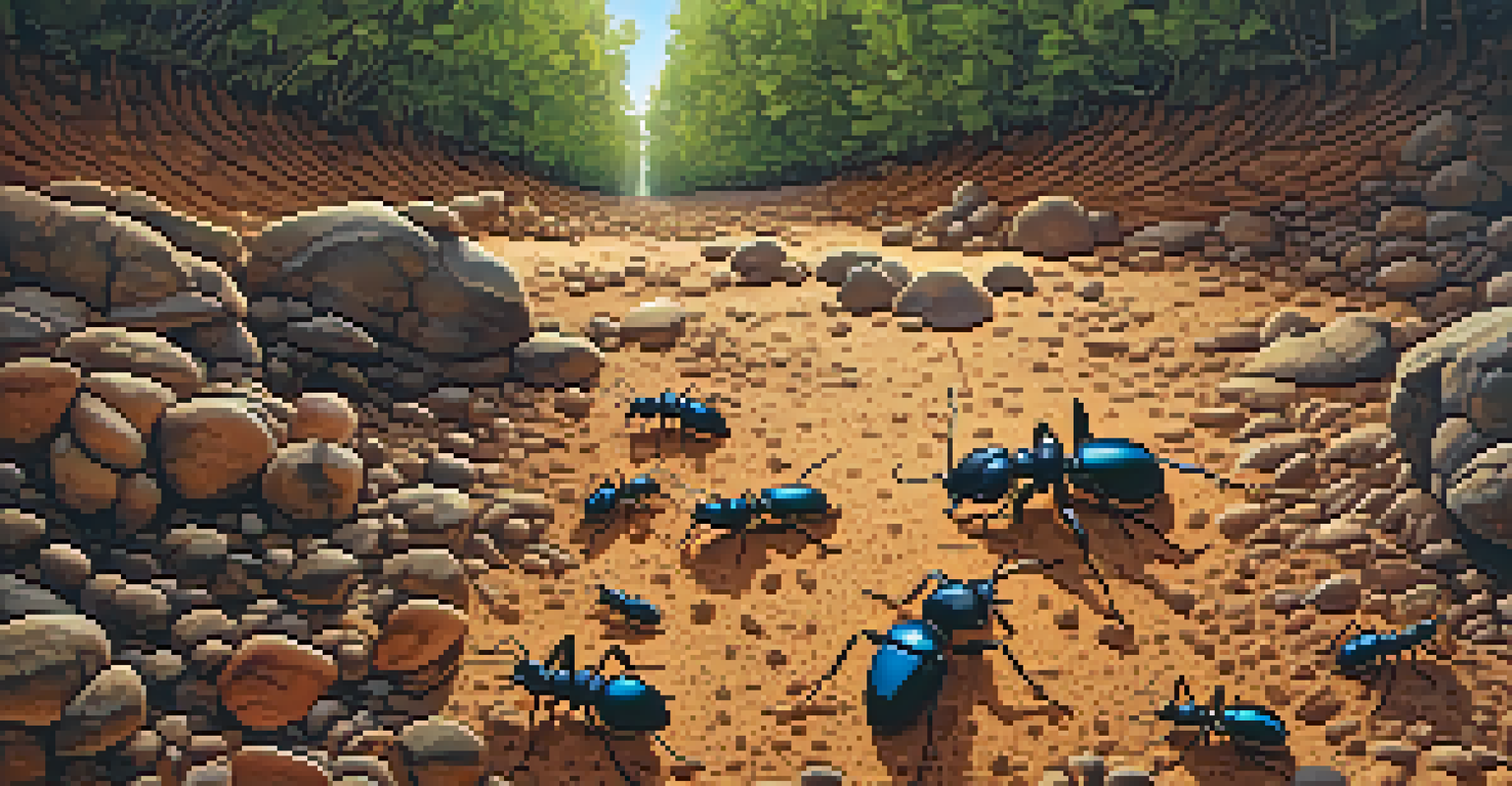The Role of Insects in Sedona's Ecosystems Explained

Insects as Pollinators in Sedona's Flora
Insects play a crucial role in pollinating the diverse plant life found in Sedona. Bees, butterflies, and beetles flutter from flower to flower, transferring pollen and facilitating the reproductive process of plants. Without these diligent pollinators, many of the beautiful blooms that attract visitors would struggle to thrive.
The butterfly counts not months but moments, and has time enough.
Consider the iconic cactus flowers in Sedona; their vibrant colors are not just for show but are designed to attract these essential insects. As they pollinate, they enable the production of seeds and fruits, which in turn support the local wildlife. This interconnectedness highlights the importance of insects in maintaining the health of the ecosystem.
Moreover, the decline in insect populations due to habitat loss and pesticides poses a significant threat to these plants. Protecting insect diversity is vital for sustaining Sedona's unique floral landscapes and ensuring that the ecosystem remains vibrant and productive.
Insects as Decomposers in Sedona's Soil
Insects like ants, beetles, and termites play a vital role as decomposers, breaking down organic matter in Sedona's ecosystems. This process enriches the soil, returning essential nutrients that support plant growth and overall ecosystem health. Imagine a bustling underground community where insects work tirelessly to recycle nutrients, creating a balanced environment.

These decomposer insects feed on dead plants and animal matter, helping to speed up the decomposition process. As they break down this material, they aerate the soil, allowing water and air to reach plant roots more effectively. This natural service is essential for sustaining the rich biodiversity that characterizes Sedona.
Insects Are Key Pollinators
Insects like bees and butterflies are essential for pollinating Sedona's diverse plant life, ensuring ecosystem health.
Furthermore, healthy soil leads to robust plant life, which in turn supports a variety of other species, including larger wildlife. The interdependence between insects and the soil ecosystem illustrates how these small creatures have a monumental impact on the overall health of Sedona's environment.
Insects as Food Sources for Sedona's Wildlife
Insects serve as a primary food source for many animals in Sedona, including birds, reptiles, and mammals. This makes them a fundamental component of the food web, supporting various species that rely on them for sustenance. Think of insects as the building blocks of wildlife nutrition, essential for maintaining healthy populations.
Insects are the little things that run the world.
For instance, many bird species in Sedona, such as the vermilion flycatcher, depend on insects for a significant portion of their diet. These birds help control insect populations while also playing a role in pollination, showcasing the interconnectedness of all species within the ecosystem. This relationship emphasizes the importance of a balanced food web.
Additionally, as predators, these wildlife species help regulate insect populations, preventing any one species from becoming too dominant. This natural balance is crucial for maintaining biodiversity, ensuring that Sedona’s ecosystems remain vibrant and resilient against environmental changes.
Insects and Soil Health in Sedona
Soil health is profoundly influenced by the activities of insects, which help aerate and enrich it. For example, earthworms, although not insects, are often associated with them and play a vital role in the ecosystem. They create channels in the soil, allowing water and nutrients to penetrate deeper, which benefits plant growth.
Insects like ants also contribute to soil health by mixing organic material into the earth, promoting microbial activity. This process not only enriches the soil but also helps retain moisture, which is particularly important in the arid climate of Sedona. By supporting healthy soil, insects indirectly promote a thriving plant community.
Insects Enrich Soil Health
Decomposer insects play a vital role in breaking down organic matter, which enhances soil nutrients and supports plant growth.
Moreover, healthy soil fosters diverse plant species, which in turn attract various insects, creating a harmonious cycle. This synergy showcases how insects are not just pests but rather invaluable allies in maintaining the ecological balance of Sedona.
The Impact of Climate Change on Insect Populations
Climate change poses a significant threat to insect populations in Sedona, with rising temperatures and altered precipitation patterns affecting their habitats. As ecosystems shift, many species struggle to adapt, leading to declines in their populations. This disruption can have cascading effects throughout the food web, impacting plants and animals alike.
For example, certain pollinators may find it challenging to time their life cycles with flowering plants due to changing seasons. This misalignment can hinder plant reproduction and diminish food sources for other wildlife. The delicate balance that insects help maintain is increasingly at risk as climate conditions continue to evolve.
Addressing climate change involves not only reducing greenhouse gas emissions but also protecting insect habitats. By fostering environments that support diverse insect populations, we can help mitigate some of the adverse effects of climate change and preserve the intricate web of life in Sedona.
Conservation Efforts for Insects in Sedona
Conservation efforts in Sedona aim to protect the vital roles insects play within ecosystems. Local organizations often focus on habitat restoration and sustainable practices to support insect populations. By creating pollinator gardens and preserving natural habitats, they help ensure that these crucial species can thrive.
Community engagement is also key; educational programs can raise awareness about the importance of insects. When people understand how insects contribute to the ecosystem, they are more likely to support conservation initiatives. This collective effort can lead to healthier landscapes and richer biodiversity in Sedona.
Climate Change Threatens Insects
Rising temperatures and changing precipitation patterns due to climate change pose significant risks to insect populations in Sedona.
Additionally, reducing pesticide use and promoting organic farming practices can significantly benefit insect populations. By fostering a culture of respect for all creatures, Sedona can continue to be a haven for insects and the diverse ecosystems they support.
The Future of Insects in Sedona's Ecosystems
The future of insects in Sedona's ecosystems depends on our collective actions and attitudes towards the environment. By prioritizing conservation and sustainable practices, we can create a more hospitable environment for these essential creatures. This not only benefits insects but also enhances the overall health of Sedona’s ecosystems.
Continued research and monitoring of insect populations will be crucial in understanding their roles and challenges. By gathering data, scientists can develop strategies to protect vulnerable species and restore those that have declined. This proactive approach will help ensure that Sedona remains a haven for diverse insect life.

Ultimately, a thriving insect population will contribute to the resilience of Sedona's ecosystems, supporting the rich biodiversity that makes the region so special. The actions we take today will shape the future landscape, highlighting the importance of nurturing our natural world.